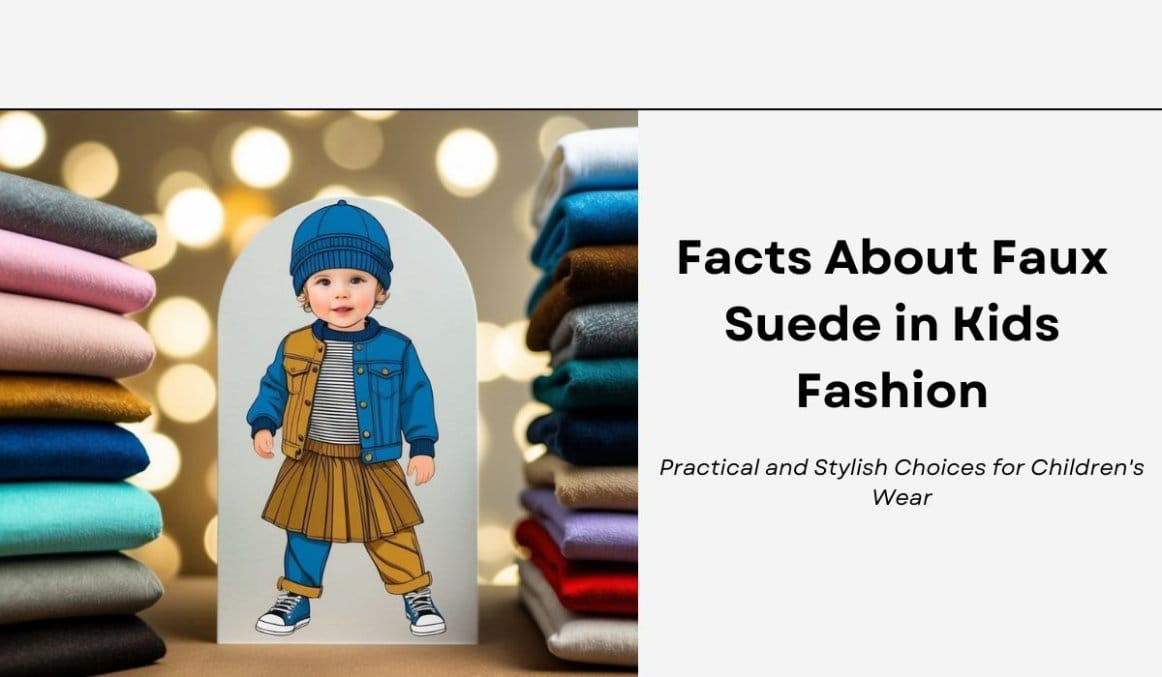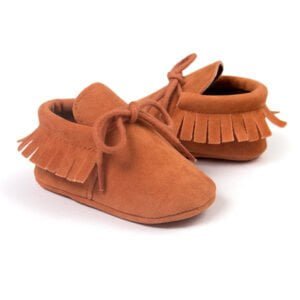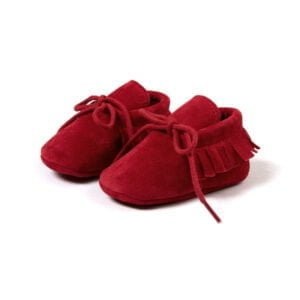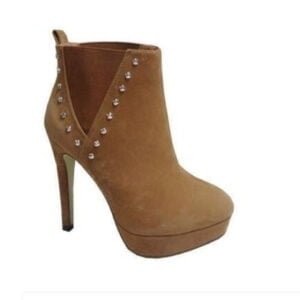Why Parents and Fashion Designers Are Choosing This Durable, Easy-Care Fabric for Growing Kids
Faux suede has become a popular fabric choice in kids’ fashion. This synthetic material mimics the look and feel of real suede but offers several advantages. It’s more durable, easier to clean, and often more affordable than genuine suede, making it ideal for children’s clothing and accessories.
Parents and fashion designers alike appreciate faux suede‘s versatility and practicality. It can be used for everything from jackets and shoes to bags and hats. Unlike real suede, faux suede is animal-friendly, appealing to families with ethical concerns about using animal products in clothing.
As we explore 10 facts about faux suede in kids’ fashion, you’ll learn why this fabric has become a staple in children’s wardrobes. From its eco-friendly properties to its durability, faux suede offers a range of benefits that make it a smart choice for young fashionistas and their parents.
On This Page
Key Takeaways
- Faux suede offers durability and easy care, making it ideal for children’s clothing
- This synthetic fabric is animal-friendly and often more affordable than genuine suede
- Faux suede’s versatility allows for its use in various kids’ fashion items, from jackets to accessories
Understanding Faux Suede
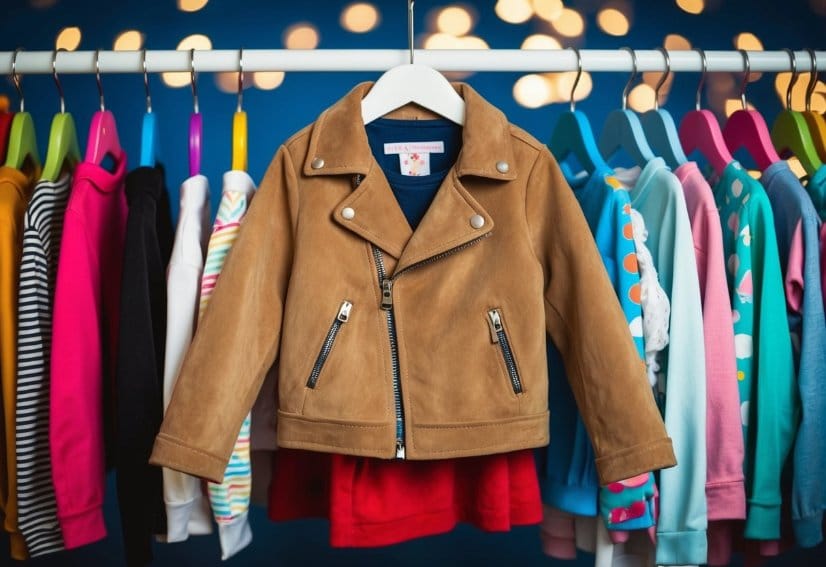
Faux suede is a popular synthetic fabric that mimics the look and feel of genuine suede. It offers a more affordable and animal-friendly alternative for use in children’s fashion.
The Basics of Faux Suede
Faux suede is a man-made fabric designed to look like real suede leather. It’s soft, durable, and easy to clean, making it ideal for kids’ clothing and accessories. Unlike genuine suede, faux suede is resistant to water and stains.
The fabric has a short, dense pile that gives it a velvety texture. It comes in a wide range of colours, allowing for versatile use in fashion design.
Faux suede is lightweight and breathable, ensuring comfort for children wearing it. It’s also less prone to scratching or marking compared to real suede.
How Faux Suede is Made
Faux suede is produced using synthetic materials. The most common components are polyester and polyurethane.
The manufacturing process involves:
- Creating a base fabric, usually from polyester
- Applying a layer of polyurethane to the fabric
- Treating the surface to create a suede-like texture
Some faux suede is made entirely from polyester microfibre. This type is especially soft and durable.
Advanced techniques allow manufacturers to create faux suede that closely resembles genuine suede in both look and feel.
Faux Suede vs Genuine Suede
Faux suede offers several advantages over genuine suede in children’s fashion:
- Cost: Faux suede is more affordable than real suede, making it accessible for a wider range of consumers.
- Durability: It’s more resistant to wear and tear, ideal for active children.
- Easy care: Faux suede is machine washable and doesn’t require special cleaning methods.
Genuine suede is made from animal hide, typically from the underside of sheep, goat, or calf skin. It’s softer and more luxurious but requires more careful maintenance.
Faux suede is more eco-friendly as it doesn’t involve animal products. However, its production does use synthetic materials, which have their own environmental considerations.
The Role of Faux Suede in Kidswear

Faux suede plays a significant part in children’s fashion. It offers a stylish look whilst being practical for active youngsters. This material has become popular for its versatility and kid-friendly qualities.
Durability and Maintenance
Faux suede is known for its durability, making it ideal for children’s clothing and accessories. It resists wear and tear better than many natural fabrics. This synthetic material stands up well to rough play and frequent washing.
Maintaining faux suede items is straightforward. Most can be machine washed, unlike real suede which requires special care. Stains are easy to remove with a damp cloth. This ease of cleaning is a big plus for busy parents.
For school jackets and everyday wear, faux suede is a smart choice. It keeps its shape and colour even after many washes. This longevity makes it a cost-effective option for growing children.
Safety and Comfort
Faux suede is generally safe for children to wear. It’s free from animal products, making it suitable for vegan families. The material is also less likely to cause allergic reactions compared to some natural fabrics.
Comfort is key in kidswear, and faux suede delivers. It’s soft to the touch, mimicking the feel of real suede. This softness makes it cosy for items like jackets and boots.
The breathability of faux suede varies. Some types allow air to circulate, keeping children comfortable. Others may not breathe as well, so it’s worth checking the specific fabric blend.
Fashion Trends in Kidswear
Faux suede is trendy in children’s fashion. It’s used in a variety of clothing items and accessories. Jackets, boots, and handbags are popular choices for this material.
Recommended products
Baby shoes girl suede moccasins – Brown
£12.99Baby shoes girl suede moccasins – Red
£12.99Women’s tan suede ankle high heel shoes
Original price was: £36.99.£24.99Current price is: £24.99.
The material comes in a wide range of colours. This variety allows for creative and fun fashion choices. Bright hues and pastel shades are common in kidswear made from faux suede.
Fashion designers often use faux suede to create miniature versions of adult styles. This lets children feel grown-up while wearing age-appropriate clothing. The material’s texture adds a touch of luxury to everyday outfits.
Faux suede also works well for special occasion wear. It can be dressed up or down, making it versatile for different events. This adaptability is valuable in children’s wardrobes.
Environmental Impact and Sustainability
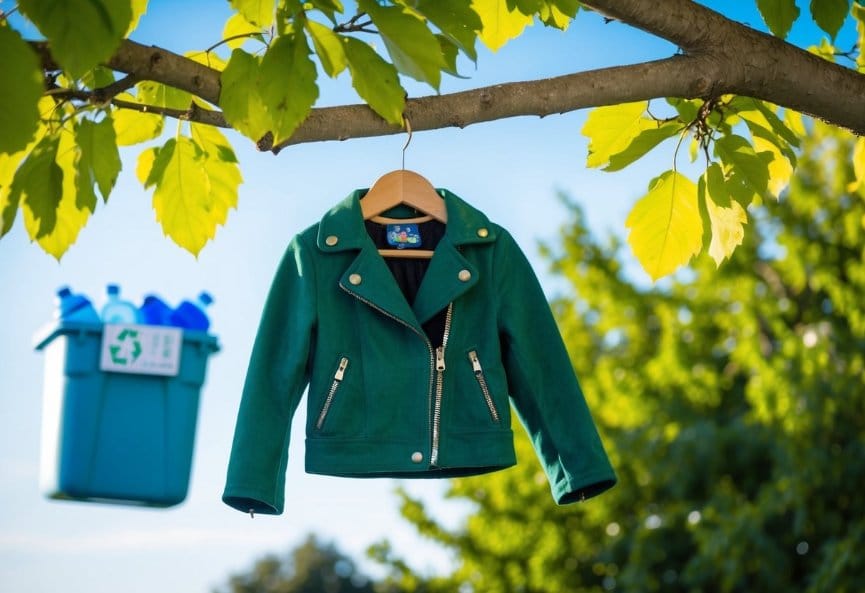
Faux suede offers both benefits and drawbacks in terms of its environmental footprint. Its production and disposal have important implications for sustainability in children’s fashion.
Eco-friendly Aspects of Faux Suede
Faux suede is an animal-friendly alternative to real suede, making it a cruelty-free option for kids’ clothing and accessories. This synthetic fabric doesn’t require raising livestock, which reduces land and water use.
Faux suede is often made from recycled materials, such as plastic bottles. This helps reduce waste and gives new life to existing resources. Some manufacturers use eco-friendly dyes and finishes, further lowering the environmental impact.
The durability of faux suede can be a sustainability advantage. Longer-lasting garments mean less frequent replacement, reducing overall consumption.
Comparing Environmental Impact
While faux suede has some eco-friendly aspects, it’s important to consider its full lifecycle impact. As a synthetic material, it’s typically made from petroleum-based products, which aren’t renewable.
Production of faux suede can involve energy-intensive processes and chemical treatments. These may release harmful substances into the environment if not properly managed.
End-of-life disposal is a concern for faux suede. Unlike natural materials, it doesn’t biodegrade easily. This can contribute to long-term pollution if not recycled or disposed of properly.
When comparing faux suede to real suede:
- Real suede: Uses animal hides, higher water use
- Faux suede: No animal products, lower water use, but non-biodegradable
The choice between the two depends on weighing different environmental factors.
Applications Beyond Fashion
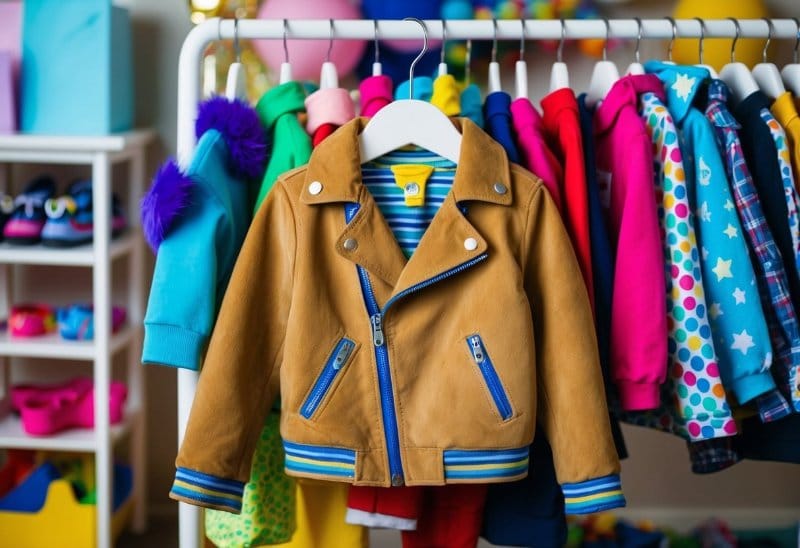
Faux suede’s versatility extends well beyond children’s clothing. Its durability and aesthetic appeal make it a popular choice for various products and industries.
Furniture and Upholstery
Faux suede is a top pick for furniture and upholstery. Its soft texture and resistance to wear make it ideal for sofas, chairs, and ottomans. The material is easy to clean, which is crucial for homes with kids.
Faux suede cushions and throws add a touch of luxury to any room. They’re perfect for playrooms, as they can withstand rough handling and spills.
Many carmakers use faux suede for car seats and interiors. It’s cheaper than real leather and holds up well to daily use.
Accessories and Other Uses
Faux suede is a hit in the world of fashion accessories. Handbags and wallets made from this material look posh but cost less than real leather.
The fabric is also used for phone cases, laptop sleeves, and tablet covers. These items protect gadgets while looking stylish.
Faux suede finds its way into home decor too. It’s used for curtains, tablecloths, and even wallpaper. The material adds a cosy feel to any space.
Craft enthusiasts love faux suede for DIY projects. It’s easy to work with and comes in many colours.
Caring for Faux Suede Products
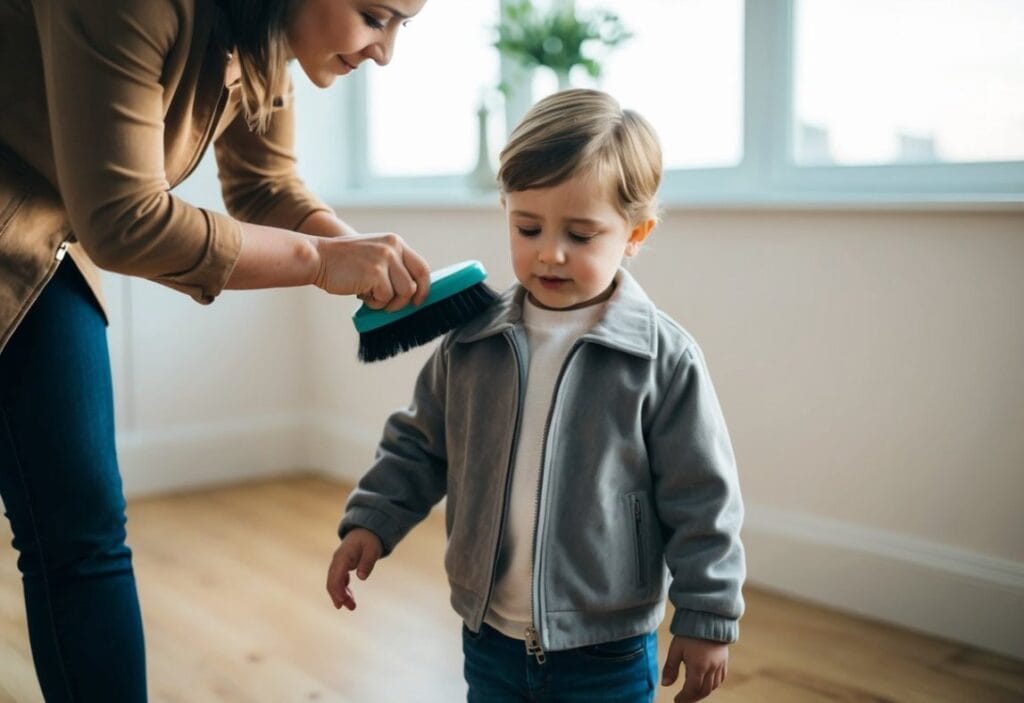
Faux suede is a popular fabric in children’s fashion due to its softness and durability. It’s important to know how to care for these items properly to keep them looking their best.
Regular maintenance is key for faux suede products. Brushing the fabric gently with a soft-bristled brush can help remove dust and dirt, keeping the material looking fresh.
For tougher stains, spot cleaning is often effective. A mixture of water and vinegar or rubbing alcohol can be used to tackle spills or marks. Always test any cleaning solution on a hidden area first.
Many faux suede items are machine washable, but it’s crucial to check the care label before washing. Use a gentle cycle with cold water and mild detergent when machine washing is appropriate.
Ironing faux suede requires caution. If needed, use a low heat setting and place a thin cloth between the iron and the fabric to prevent damage.
To protect faux suede items, store them in a cool, dry place away from direct sunlight. This helps prevent fading and maintains the fabric’s texture.
By following these care tips, faux suede products in children’s fashion can remain durable and attractive for a long time, making them a practical choice for parents.
Choosing High-Quality Faux Suede
When selecting faux suede for children’s fashion, it’s crucial to consider both quality and affordability. The right choice balances a realistic appearance with durability and cost-effectiveness.
Identifying Superior Faux Suede
To spot high-quality faux suede, examine its texture and appearance. Good faux suede should have a soft, velvety feel similar to real suede. Run your hand over the fabric – it should have a slight nap that changes direction when brushed.
Check the colour consistency. Quality faux suede has an even tone without patchy areas. Look for a matte finish that mimics genuine suede’s look.
Assess the fabric’s thickness and weight. Better faux suedes tend to be slightly heavier and more substantial. This often indicates better durability and a more luxurious feel.
Stretch the fabric gently. High-quality faux suede should have some give without losing its shape. It shouldn’t feel stiff or plasticky.
Price vs Quality Considerations
While faux suede is generally more affordable than real suede, prices can vary. Higher-quality faux suedes often cost more but may offer better value in the long run.
Consider the intended use. For everyday children’s wear, a mid-range faux suede might suffice. For special occasions or items that need to last, investing in a pricier, higher-quality option could be wise.
Look for sales or bulk discounts if you need larger quantities. Some retailers offer better prices for bigger orders, which can help balance cost and quality.
Remember, extremely cheap faux suede might not hold up well to wear and tear. It’s often worth paying a bit more for a product that will last longer and look better.
Historical Perspective and Evolution
Suede has a rich history spanning centuries, evolving from animal hides to synthetic alternatives. Its journey reflects changing attitudes towards materials and production methods in fashion.
Origins of Suede
Suede originated from the underside of animal skins, particularly lambs, goats, and calves. The term ‘suede’ comes from the French phrase ‘gants de Suède’, meaning ‘gloves from Sweden’. Early uses of suede date back to prehistoric times when hunters used animal hides for warmth and protection.
In the 18th century, suede gained popularity in Europe for gloves and other accessories. Its soft texture and durability made it a favourite among the upper classes. The production process involved splitting the hide and working the flesh side to create a napped finish.
By the 19th century, suede had become a staple in fashion, used in shoes, jackets, and handbags. Its unique texture and appearance set it apart from smooth leather.
Development of Synthetic Alternatives
As concerns about animal welfare grew, manufacturers sought alternatives to natural suede. The 20th century saw the development of synthetic suede fabrics. These materials aimed to mimic the look and feel of suede without using animal products.
One of the first synthetic suedes was Ultrasuede, invented in the 1970s. Made from polyester fibres, it offered a suede-like texture and durability. Other versions followed, using different combinations of synthetic fibres and manufacturing techniques.
Faux suede became popular in children’s fashion due to its softness, ease of care, and lower cost. It allowed for more colourful and playful designs in kids’ clothing and accessories. Today, faux suede is widely used in the fashion industry, offering a cruelty-free and often more affordable option for suede-like products.
The Future of Faux Suede in Fashion
Faux suede is set to play a big role in future fashion trends. Its animal-friendly nature makes it a top choice for sustainable fashion.
The fashion industry is always looking for new materials. Faux suede fits the bill as it’s cheaper to make and easier to work with than real suede.
Innovation in fabric technology will likely improve faux suede’s quality. This could make it feel even more like the real thing.
Some key future trends for faux suede include:
- More colours and prints
- Better water resistance
- Lighter weight fabrics
- Improved durability
Faux suede may become a go-to material for eco-conscious brands. It allows them to create stylish products without using animal products.
Fast fashion stores are expected to use more faux suede. It’s a cost-effective way to offer trendy items to shoppers.
As techniques improve, faux suede could be used in high-end fashion too. Designers might mix it with other fabrics to create unique textures.
The future looks bright for faux suede in the fashion world. Its versatility and eco-friendly status make it a fabric to watch.
Frequently Asked Questions
Faux suede is a popular material in children’s fashion. It offers unique qualities and benefits for kids’ clothing and footwear.
What are the distinguishing characteristics of faux suede when used in children’s clothing?
Faux suede in children’s clothing is soft and comfortable. It has a velvety texture similar to real suede but is lighter in weight.
The material is also more durable and resistant to stains compared to genuine suede. This makes it practical for active children.
How do you care for kids’ garments made of faux suede?
Faux suede is easy to care for. Most items can be machine washed on a gentle cycle with cold water.
Avoid using harsh detergents or bleach. Air drying is best to maintain the fabric’s texture and shape.
What are the environmental impacts of using faux suede in children’s fashion?
Faux suede is vegan-friendly as it doesn’t use animal products. This reduces the environmental impact associated with animal farming.
However, faux suede is often made from synthetic materials like polyester. These can take a long time to break down in landfills.
In comparison to genuine suede, what advantages does faux suede offer for kids’ apparel?
Faux suede is more affordable than real suede, making it budget-friendly for growing children. It’s also more resistant to water and stains.
The material is lightweight and breathable, keeping kids comfortable during play. It’s also easier to clean than genuine suede.
How can one identify faux suede from real suede in children’s shoes?
Faux suede often has a more uniform texture than real suede. It may feel slightly smoother to the touch.
Check the care label. Faux suede items can usually be machine washed, while real suede requires special care.
What are the latest trends in children’s fashion incorporating faux suede?
Faux suede is popular in children’s boots and shoes, offering a stylish look with practical benefits. It’s also used in jackets and accessories like bags.
Some brands are using colourful faux suede to create fun, vibrant designs for children’s clothing and accessories.
Related Post: What You Need to Know About Faux Suede: A Comprehensive Guide to This Versatile Fabric

